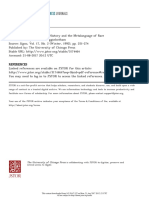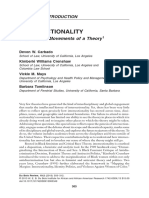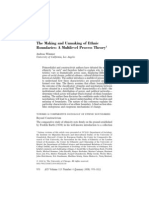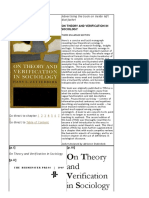Critical Race Theory
Critical Race Theory
Uploaded by
Max TeixeiraCopyright:
Available Formats
Critical Race Theory
Critical Race Theory
Uploaded by
Max TeixeiraOriginal Title
Copyright
Available Formats
Share this document
Did you find this document useful?
Is this content inappropriate?
Copyright:
Available Formats
Critical Race Theory
Critical Race Theory
Uploaded by
Max TeixeiraCopyright:
Available Formats
Cri$cal Race Theory
h"ps://owl.purdue.edu/owl/subject_specific_wri6ng/wri6ng_in_literature/
literary_theory_and_schools_of_cri6cism/cri6cal_race_theory.html
Critical Race Theory, or CRT, is a theoretical and interpretive mode that examines the
appearance of race and racism across dominant cultural modes of expression. In
adopting this approach, CRT scholars attempt to understand how victims of systemic
racism are affected by cultural perceptions of race and how they are able to represent
themselves to counter prejudice.
Closely connected to such fields as philosophy, history, sociology, and law, CRT
scholarship traces racism in America through the nation’s legacy of slavery, the Civil
Rights Movement, and recent events. In doing so, it draws from work by writers like
Sojourner Truth, Frederick Douglass, W.E.B. Du Bois, Martin Luther King, Jr., and
others studying law, feminism, and post-structuralism. CRT developed into its current
form during the mid-1970s with scholars like Derrick Bell, Alan Freeman, and Richard
Delgado, who responded to what they identified as dangerously slow progress following
Civil Rights in the 1960s.
Prominent CRT scholars like Kimberlé Crenshaw, Mari Matsuda, and Patricia Williams
share an interest in recognizing racism as a quotidian component of American life
(manifested in textual sources like literature, film, law, etc). In doing so, they attempt to
confront the beliefs and practices that enable racism to persist while also challenging
these practices in order to seek liberation from systemic racism.
As such, CRT scholarship also emphasizes the importance of finding a way for diverse
individuals to share their experiences. However, CRT scholars do not only locate an
individual’s identity and experience of the world in his or her racial identifications, but
also their membership to a specific class, gender, nation, sexual orientation, etc. They
read these diverse cultural texts as proof of the institutionalized inequalities racialized
groups and individuals experience every day.
In their seminal book, Critical Race Theory: An Introduction, Delgado
and Stefencic introduced critical race theory to the social sciences
more broadly. Delgado and Stefencic claimed that critical race theory
is based around the following premises:
• Racism is ordinary, not aberrational.
• Racism serves important purposes.
• Race and races are products of social thought and relations
[and] categories that society invents, manipulates, or retires
when convenient’ (Delgado and Stefencic, 2001: 7).
• Intersectionality: ‘No person has a single, easily stated, unitary
identity […] everyone has potentially conflicting, overlapping
identities, loyalties and allegiances’ (Delgado and Stefencic,
2001: 9).
More recently, Bonilla-Silva (2015: 74) has redeveloped the tenets of
CRT to the following:
• Racism is ‘embedded in the structure of society’.
• Racism has a ‘material foundation’.
• Racism changes and develops over different times.
• Racism is often ascribed a degree of rationality.
• Racism has a contemporary basis.
Central to critical race theory is that racism is much more than
individual prejudice and bigotry; rather, racism is a systemic feature of
social structure. Given that racism is so deeply embedded in social
structure, Bonilla-Silva argues that racial inequality often gets
misrecognised as a natural process rather than a by-product of a
system of racial domination (what he refers to as a ‘racialised social
system’). One example Bonilla-Silva uses is the issue of white
segregation in the US: while they remain one of the most socially
segregated groups in the country; rather than explaining this through
processes such as housing discrimination and whites seeking to ‘flock
together’, this reality is often explained away through a colourblind
logic such that ‘like-minded people naturally gravitate towards each
other’.
Critical race theory offers an invaluable set of literature for scholars of
race and society to engage with. As a social scientific approach, it
encourages us to appreciate how races are constructed into
hierarchies, with societal resources distributed unequally across this
hierarchy. In a time often declared as ‘post-racial’, critical race theory
helps remind us that race is omnirelevant – it may not always be the
single determining factor of a given inequality, nor even the most
important one, but ‘race’ is fundamental to understanding current
regimes of inequality, and that analyses of inequality and its inverse
(privilege and domination), are incomplete without a systematic
discussion of race.
Works Cited
Delgado, Richard and Jean Stefancic. Critical Race Theory: An Introduction. 2nd ed. New
York: New York University Press, 2012.
Delgado, Richard and Jean Stefancic, eds. Critical Race Theory: The Cutting
Edge. 3rd ed. Philadelphia: Temple University Press, 2013. Print.
Recommended Sources for Additional Research
Bell, Derrick A. “Who’s Afraid of Critical Race Theory?” University of Illinois Law
Review 4 (1995): 893-910.
Crenshaw, Kimberlé, Neil Gotanda, Gary Peller, and Kendall Thomas, eds. Critical Race
Theory: The Key Writings that Formed the Movement. New York: The New Press, 1995
Davis, Peggy. “Law as Microaggression.” Yale Law Journal 98 (1989): 1559-1577.
Gates, Henry Louis. The Signifying Monkey: A Theory of African American Literary
Criticism. New York: Oxford University Press, 2014.
Harris, Cheryl. “Whiteness as Property.” Harvard Law Review 106.8 (1993): 1707-1791.
hooks, bell. Feminist Theory: From the Margins to the Center. Boston: South End Press,
1984.
Lipsitz, George. The Possessive Investment in Whiteness: How White People Profit
from Identity Politics. Philadelphia: Temple University Press, 1998.
Spillers, Hortense. “Mama’s Baby, Papa’s Maybe: An American Grammar
Book.” Diacritics 17.2 (1987): 64-81.
Williams, Patricia. Seeing a Color-Blind Future: The Paradox of Race. New York:
Noonday Press, 1998.
You might also like
- The Psychology of Technical AnalysisDocument15 pagesThe Psychology of Technical AnalysisShyam Sunder67% (3)
- 1H Legal Technique Reviewer Legal Logic by Evangelista and Aquino 2015Document29 pages1H Legal Technique Reviewer Legal Logic by Evangelista and Aquino 2015Rex GodMode90% (10)
- Carbado 2013Document36 pagesCarbado 2013rappan semaNo ratings yet
- Zuberi, Tukufu. Critical Race Theory of Society (2011) PDFDocument19 pagesZuberi, Tukufu. Critical Race Theory of Society (2011) PDFVinícius Romão100% (1)
- Critical RACE TheoryDocument21 pagesCritical RACE TheoryVictor Albuquerque100% (4)
- Eye Movement Desensitization & Reprocessing (EMDR) Therapy: Michael K, MS3Document7 pagesEye Movement Desensitization & Reprocessing (EMDR) Therapy: Michael K, MS3michael karp100% (1)
- Hunter Racial Epistem On Soc Sci MethodsDocument20 pagesHunter Racial Epistem On Soc Sci MethodsBlythe TomNo ratings yet
- Critical Race Theory HandoutDocument1 pageCritical Race Theory Handoutapi-385542384No ratings yet
- Zuberi Connet Law RevDocument19 pagesZuberi Connet Law RevBlythe TomNo ratings yet
- Critical Race Theory and Criminal JusticeDocument13 pagesCritical Race Theory and Criminal JusticeliviugNo ratings yet
- Jin Haritaworn (Chapter-3)Document35 pagesJin Haritaworn (Chapter-3)Charlie Abdullah HaddadNo ratings yet
- Higginbotham African American Womens History RaceDocument25 pagesHigginbotham African American Womens History Raceelyse_mds100% (1)
- The Concept of Intersectionality RoutledDocument29 pagesThe Concept of Intersectionality RoutledmjacquinetNo ratings yet
- ASC233-Hollinsworth David-Race and Racism in Australia-Racism Concepts Theories and Approaches-Pp40-51Document13 pagesASC233-Hollinsworth David-Race and Racism in Australia-Racism Concepts Theories and Approaches-Pp40-51PNo ratings yet
- 1973 - Pettigrew - Ethnocentrism-Theories of Conflict, Ethnic Attitudes and Group Behavior (LeVine&Cambell)Document3 pages1973 - Pettigrew - Ethnocentrism-Theories of Conflict, Ethnic Attitudes and Group Behavior (LeVine&Cambell)Fiorella CapchaNo ratings yet
- Crenshaw.Mapping the Margins.Intersectionality, Identity Politics, and Violence against Women of ColorDocument60 pagesCrenshaw.Mapping the Margins.Intersectionality, Identity Politics, and Violence against Women of ColorAlberto Vladimir Castillo VenturaNo ratings yet
- Critical Race Theory: A Clear Introduction to CRT Movement, Racism, Hate, Occupational Hierarchy, and How it Concerns YouFrom EverandCritical Race Theory: A Clear Introduction to CRT Movement, Racism, Hate, Occupational Hierarchy, and How it Concerns YouRating: 2 out of 5 stars2/5 (1)
- HiggenbothamDocument25 pagesHiggenbothamMary GaoNo ratings yet
- Crt OriginalDocument3 pagesCrt OriginalJoseph Privat Yemnga MemNo ratings yet
- 2021 - Burkette Warhol - Crossing Borders Making ConnectionsDocument17 pages2021 - Burkette Warhol - Crossing Borders Making Connectionsviviperez084No ratings yet
- Critical Race TheoryDocument16 pagesCritical Race TheoryKama LizaNo ratings yet
- My Paper PropertyDocument13 pagesMy Paper PropertySudip PatraNo ratings yet
- Intersectional Criminology Identity and PowerDocument14 pagesIntersectional Criminology Identity and PowerPatríciaMartinsNo ratings yet
- Lindsay Perez Huber DissertationDocument7 pagesLindsay Perez Huber DissertationCustomCollegePapersCanada100% (3)
- Wa0000.Document5 pagesWa0000.abdulazeez FatimaNo ratings yet
- Intersectionality Wiki PDFDocument53 pagesIntersectionality Wiki PDFsanjnuNo ratings yet
- Delgado & Stefancic - Critical Race Theory & Criminal Justice-3Document14 pagesDelgado & Stefancic - Critical Race Theory & Criminal Justice-3HKRSLNo ratings yet
- Critical Race TheoryDocument3 pagesCritical Race TheoryElena Arvaniti100% (1)
- The Making and Unmaking of Ethnic Boundaries: A Multilevel Process TheoryDocument53 pagesThe Making and Unmaking of Ethnic Boundaries: A Multilevel Process TheoryjackbillingsullivanNo ratings yet
- 8 Bonilla Silva 2011Document17 pages8 Bonilla Silva 2011AitanaNo ratings yet
- This Content Downloaded From 64.28.139.216 On Wed, 19 Jan 2022 23:03:08 UTCDocument25 pagesThis Content Downloaded From 64.28.139.216 On Wed, 19 Jan 2022 23:03:08 UTCjkuizon1No ratings yet
- Intersectionality Essay.docxDocument10 pagesIntersectionality Essay.docxNathan UdehNo ratings yet
- Sociology of RacismDocument14 pagesSociology of RacismMelodyNo ratings yet
- AnnotatedbibliographyDocument7 pagesAnnotatedbibliographyapi-451558425No ratings yet
- CRT NotesDocument7 pagesCRT NotesElena ArvanitiNo ratings yet
- Crenshaw - Mapping The Margins PDFDocument60 pagesCrenshaw - Mapping The Margins PDFFelipe MilanezNo ratings yet
- Ajari N2022 SCJCPForms of DeathDocument27 pagesAjari N2022 SCJCPForms of DeathIsaias Tchiica FalauNo ratings yet
- Carbado, Crenshaw, Mays & Tomlinson (2013) IntersectionalityDocument11 pagesCarbado, Crenshaw, Mays & Tomlinson (2013) IntersectionalitySolSomozaNo ratings yet
- HartmannGerteis MulticulturalismDocument24 pagesHartmannGerteis MulticulturalismVisnja FlegarNo ratings yet
- Mapping The Margins ArticleDocument60 pagesMapping The Margins ArticleCrystalNo ratings yet
- Handout2 Intersect Sweden11Document2 pagesHandout2 Intersect Sweden11Katie KingNo ratings yet
- Understanding Racism and The Role of Identity Politics in Anti-Racism Movements in AmericaDocument5 pagesUnderstanding Racism and The Role of Identity Politics in Anti-Racism Movements in AmericaInternational Journal of Innovative Science and Research TechnologyNo ratings yet
- Fearon ViolenceSocialConstruction 2000Document34 pagesFearon ViolenceSocialConstruction 2000Atticus Flanagan-BurtNo ratings yet
- Socio Caste and ClasssDocument24 pagesSocio Caste and Classsshubhamnv057No ratings yet
- Crenshow 1991 IntersectionalityDocument60 pagesCrenshow 1991 IntersectionalityVeronika LajosNo ratings yet
- Critical Race TheoryDocument13 pagesCritical Race TheorySudip Patra100% (1)
- Introduction of Mapping The MarginsDocument6 pagesIntroduction of Mapping The MarginsDanielle LNo ratings yet
- IntersectionalityDocument53 pagesIntersectionalityRodriguez100% (1)
- Reflexive Ethnography A Guide To ResearcDocument2 pagesReflexive Ethnography A Guide To ResearcWasima TabassumNo ratings yet
- Decolonizing Methodologies Linda Tuhiwai SmithDocument5 pagesDecolonizing Methodologies Linda Tuhiwai SmithRafael Hitsé RõrhyxyNo ratings yet
- 1973 - Van Der Slik - Ethnocentrism-Theories of Conflict, Ethnic Attitudes and Group Behavior (LeVine&Cambell)Document4 pages1973 - Van Der Slik - Ethnocentrism-Theories of Conflict, Ethnic Attitudes and Group Behavior (LeVine&Cambell)Fiorella CapchaNo ratings yet
- RacismDocument4 pagesRacismDoctora ArjNo ratings yet
- Mapping The MarginsDocument60 pagesMapping The MarginsPengyu CHENNo ratings yet
- Whose Culture Has Capital A Critical Race Theory Discussion of Community Cultural WealthDocument24 pagesWhose Culture Has Capital A Critical Race Theory Discussion of Community Cultural WealthTheronP41613No ratings yet
- Raising Victims: The Pernicious Rise of Critical Race TheoryFrom EverandRaising Victims: The Pernicious Rise of Critical Race TheoryNo ratings yet
- Kirwan Institute - Structural Racism BibliographyDocument14 pagesKirwan Institute - Structural Racism BibliographyradiorahimNo ratings yet
- Whose Culture Has Capital? A Critical Race Theory Discussion of Community Cultural WealthDocument24 pagesWhose Culture Has Capital? A Critical Race Theory Discussion of Community Cultural WealthStephanie WangNo ratings yet
- Tambahan RacismDocument3 pagesTambahan RacismFadli YogaNo ratings yet
- Culture, Prejudice, Racism, and DiscriminationDocument17 pagesCulture, Prejudice, Racism, and DiscriminationLola Abrahams AbelNo ratings yet
- The Making and Unmaking of Ethnic Boundaries: A Multilevel Process TheoryDocument53 pagesThe Making and Unmaking of Ethnic Boundaries: A Multilevel Process TheoryCarlos Sardiña GalacheNo ratings yet
- 2006 BROWN (TR.) Jabirian AlchemyDocument26 pages2006 BROWN (TR.) Jabirian AlchemyDannieCaesarNo ratings yet
- The SimileDocument30 pagesThe SimileBakytbek100% (6)
- Entry Patterns Over The Product Life CycleDocument17 pagesEntry Patterns Over The Product Life CycleavelagalaNo ratings yet
- Aida Smailbegović, Visual Depiction of The City of MeccaDocument17 pagesAida Smailbegović, Visual Depiction of The City of Meccamirza hasan cemanNo ratings yet
- Early Christian Reliquaries in The Republic of Macedonia - Snežana FilipovaDocument15 pagesEarly Christian Reliquaries in The Republic of Macedonia - Snežana FilipovaSonjce Marceva50% (2)
- Pengukuran Kinerja Perusahaan Menggunakan Metode: (Studi Kasus Pada PT. Retailindo)Document8 pagesPengukuran Kinerja Perusahaan Menggunakan Metode: (Studi Kasus Pada PT. Retailindo)Nafdhea HirataNo ratings yet
- 0330-0395, Gregorius Nyssenus, Against Apollinarius, enDocument62 pages0330-0395, Gregorius Nyssenus, Against Apollinarius, en123KalimeroNo ratings yet
- Narrative TextDocument5 pagesNarrative TextDewa Ayu VeronicaNo ratings yet
- Cracow Siddhayogesvari and Various Vaisnava ThingsDocument87 pagesCracow Siddhayogesvari and Various Vaisnava ThingsJASON SCHWARTZ100% (1)
- Important Instructions For The School Principal: (Not To Be Printed With The Question Paper)Document13 pagesImportant Instructions For The School Principal: (Not To Be Printed With The Question Paper)sharvan_creativeNo ratings yet
- PE Curriculum GuideDocument23 pagesPE Curriculum GuideMelencio Jr BucioNo ratings yet
- Session 12 - TL Progressive Scheme & Badge SystemDocument17 pagesSession 12 - TL Progressive Scheme & Badge SystemJoezar Barreto67% (3)
- Zetterberg, On Theory and Verification in SociologyDocument70 pagesZetterberg, On Theory and Verification in SociologyFlávia FrancoNo ratings yet
- Causes of War CSS Notes IRDocument9 pagesCauses of War CSS Notes IRNawalRamayNo ratings yet
- Ge 11 Ethics ReviewerDocument6 pagesGe 11 Ethics ReviewerWalwal WalwalNo ratings yet
- QuestionnaireDocument4 pagesQuestionnairevishal chauhanNo ratings yet
- Urban Traces Introduction PDFDocument47 pagesUrban Traces Introduction PDFZackNo ratings yet
- C de Vries, S. L., Hoeve, M., Assink, M., Stams, G. J. J., & Asscher, J. J. (2015) .Document14 pagesC de Vries, S. L., Hoeve, M., Assink, M., Stams, G. J. J., & Asscher, J. J. (2015) .Ign EcheverríaNo ratings yet
- Exploring TBLT in A Japanese EFL ESP ContextDocument24 pagesExploring TBLT in A Japanese EFL ESP ContextDan HoughamNo ratings yet
- Ii. Public Administration As A Developing DisciplineDocument37 pagesIi. Public Administration As A Developing DisciplineTareq Hasssan RumelNo ratings yet
- Pecs Module in Ict 2Document27 pagesPecs Module in Ict 2Alona Nieva100% (3)
- Synthesis PaperDocument5 pagesSynthesis Papermay rose doricoNo ratings yet
- 3.becoming An AchieverDocument46 pages3.becoming An AchieverAmera Ali AgaoNo ratings yet
- Learning Activity Sheets: Organization and ManagementDocument4 pagesLearning Activity Sheets: Organization and ManagementKimberly LagmanNo ratings yet
- Schneider Review of Moore's The Dependent Gene PDFDocument15 pagesSchneider Review of Moore's The Dependent Gene PDFfuck offNo ratings yet
- 1 Monster Journal 4Document15 pages1 Monster Journal 4hazard123100% (3)
- Going A JourneyDocument10 pagesGoing A Journeyrabin dasNo ratings yet

























































































